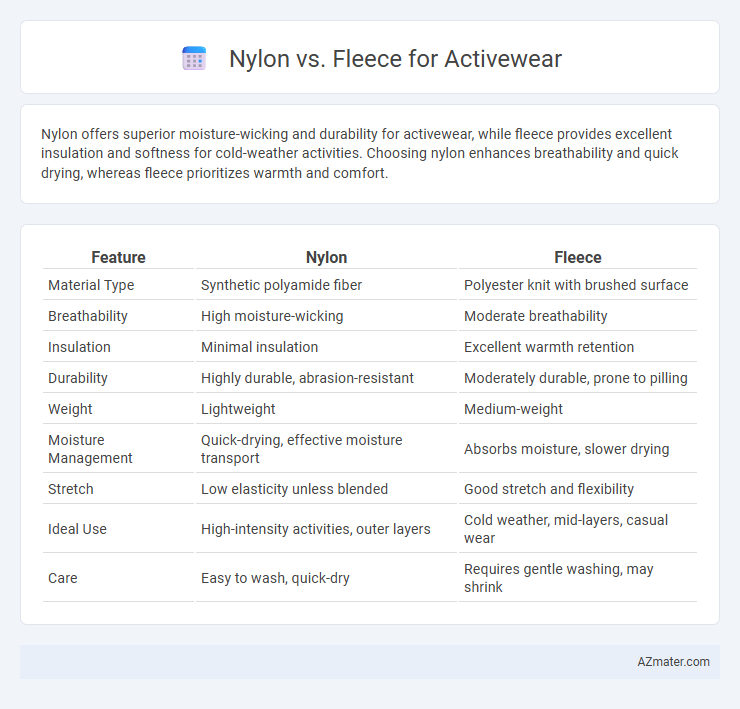Nylon offers superior moisture-wicking and durability for activewear, while fleece provides excellent insulation and softness for cold-weather activities. Choosing nylon enhances breathability and quick drying, whereas fleece prioritizes warmth and comfort.
Table of Comparison
| Feature | Nylon | Fleece |
|---|---|---|
| Material Type | Synthetic polyamide fiber | Polyester knit with brushed surface |
| Breathability | High moisture-wicking | Moderate breathability |
| Insulation | Minimal insulation | Excellent warmth retention |
| Durability | Highly durable, abrasion-resistant | Moderately durable, prone to pilling |
| Weight | Lightweight | Medium-weight |
| Moisture Management | Quick-drying, effective moisture transport | Absorbs moisture, slower drying |
| Stretch | Low elasticity unless blended | Good stretch and flexibility |
| Ideal Use | High-intensity activities, outer layers | Cold weather, mid-layers, casual wear |
| Care | Easy to wash, quick-dry | Requires gentle washing, may shrink |
Introduction: Nylon vs Fleece in Activewear
Nylon offers exceptional durability, moisture-wicking properties, and lightweight comfort, making it ideal for high-intensity activewear. Fleece excels in thermal insulation and softness, providing warmth during low-impact or cold-weather activities. Choosing between nylon and fleece depends on activity type, desired temperature regulation, and performance needs.
Material Composition and Characteristics
Nylon, a synthetic polymer known for its durability and moisture-wicking properties, offers lightweight comfort and excellent abrasion resistance, making it ideal for high-intensity activewear. Fleece, typically made from polyester fibers, provides superior insulation and breathability with a soft, plush texture that retains warmth without excessive weight. Both materials excel in stretch and quick-drying capabilities, but nylon's strength suits outdoor activities, while fleece benefits cooler conditions due to its thermal regulation.
Breathability and Moisture-Wicking Abilities
Nylon in activewear offers superior breathability due to its lightweight, smooth fibers that allow air circulation, keeping the body cool during intense workouts. Its excellent moisture-wicking abilities rapidly pull sweat away from the skin to the fabric's surface, enhancing evaporation and maintaining dry comfort. Fleece, while warm and insulating, generally lacks the same level of breathability and moisture management, making nylon preferable for high-intensity activities requiring efficient sweat control.
Warmth and Insulation Comparison
Nylon offers excellent wind resistance and quick-drying properties, making it suitable for activewear in mild to moderate cold conditions. Fleece provides superior warmth and insulation due to its thick, soft pile that traps heat effectively, ideal for colder environments. While nylon excels in moisture management and durability, fleece outperforms in thermal retention, crucial for maintaining body heat during low-intensity activities or cold weather.
Durability and Longevity
Nylon exhibits superior durability for activewear due to its high tensile strength, abrasion resistance, and ability to maintain shape after repeated use and wash cycles. Fleece, while comfortable and insulating, tends to pill and degrade faster with frequent wear and laundering, reducing its longevity in high-intensity activities. Choosing nylon enhances activewear performance and lifespan, especially in demanding environments where fabric resilience is critical.
Comfort and Fit for Active Lifestyles
Nylon offers superior moisture-wicking properties and a lightweight, stretchy fit ideal for high-intensity workouts, ensuring maximum comfort during movement. Fleece provides excellent insulation and a soft, cozy feel, making it perfect for low-impact activities or cooler environments where warmth is essential. Choosing between nylon and fleece depends on activity type and climate, with nylon excelling in breathability and fit, while fleece prioritizes warmth and softness.
Weight and Flexibility Factors
Nylon excels in activewear with its lightweight properties and exceptional flexibility, making it ideal for high-intensity workouts and dynamic movements. Fleece, while heavier and less flexible, offers superior insulation and warmth, suitable for outdoor activities in colder conditions. Choosing between nylon and fleece depends on the desired balance between weight, mobility, and thermal comfort in activewear performance.
Maintenance and Care Requirements
Nylon activewear requires minimal maintenance, offering high durability, quick drying, and resistance to shrinking and wrinkles, making it easy to care for after intense workouts. Fleece, while warm and cozy, demands more careful laundering to prevent pilling and maintain softness, often needing gentle wash cycles and air drying. Proper care of fleece involves avoiding high heat and fabric softeners, which can degrade its insulating properties over time.
Environmental Impact and Sustainability
Nylon production relies heavily on petrochemicals, resulting in high carbon emissions and non-biodegradable waste, whereas fleece, often made from recycled polyester, reduces landfill impact by repurposing plastic bottles. However, both materials contribute to microplastic pollution during washing, posing challenges for ocean health. Choosing recycled nylon or recycled fleece with certified eco-labels enhances sustainability in activewear by minimizing resource use and environmental harm.
Choosing the Best Fabric for Your Activities
Nylon offers exceptional durability, moisture-wicking properties, and quick-drying capabilities, making it ideal for high-intensity activities and outdoor workouts. Fleece provides superior insulation, softness, and breathability, which is perfect for cooler weather and low-impact exercises like hiking or yoga. Choosing the best fabric depends on your activity's intensity and temperature, with nylon suited for performance and fleece for comfort and warmth.

Infographic: Nylon vs Fleece for Activewear
 azmater.com
azmater.com